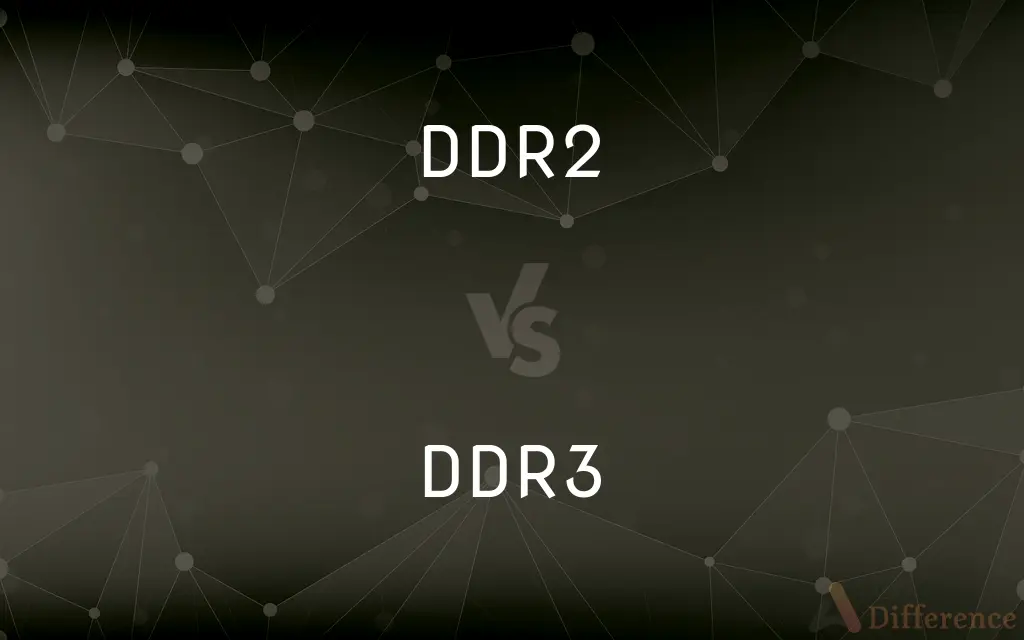DDR2 vs. DDR3 — What's the Difference?
By Tayyaba Rehman — Published on January 5, 2024
DDR2 and DDR3 are both types of DDR (Double Data Rate) RAM, with DDR3 offering faster speeds and lower power consumption than DDR2.

Difference Between DDR2 and DDR3
Table of Contents
ADVERTISEMENT
Key Differences
DDR2 and DDR3 stand for Double Data Rate 2 and Double Data Rate 3, respectively. Both are iterations of synchronous dynamic random-access memory (SDRAM) that differ in speed, architecture, and power efficiency.
The primary distinguishing feature between DDR2 and DDR3 is their speed. DDR3 offers faster transfer rates, meaning it can process more data in the same amount of time compared to DDR2.
While discussing power consumption, DDR3 holds a clear advantage. DDR3 modules operate at a lower voltage than DDR2, resulting in better energy efficiency. For devices like laptops, the energy efficiency of DDR3 can translate to slightly improved battery life.
From a compatibility perspective, DDR2 and DDR3 are not interchangeable. They possess different pin configurations and are not cross-compatible with motherboards designed for the other type. Users upgrading their RAM need to ensure they choose the correct DDR version compatible with their motherboard.
As technology has advanced, DDR3 has largely replaced DDR2 in newer devices and systems, thanks to its improved performance metrics. However, DDR2 may still be found in older systems or devices that haven't been updated or upgraded.
ADVERTISEMENT
Comparison Chart
Transfer Rates
Up to 1,066 MT/s
800 to 2,133 MT/s
Voltage
1.8V
1.5V (standard), 1.35V (low voltage)
Pin Count
240 pins (DIMM), 200 pins (SO-DIMM)
240 pins (DIMM), 204 pins (SO-DIMM)
Prefetch Buffer
4-bit
8-bit
Release Date
2003
2007
Compare with Definitions
DDR2
A second-generation Double Data Rate SDRAM.
Older computers in our office still run on DDR2 memory modules.
DDR3
RAM with an 8-bit prefetch buffer for faster data transfer.
The enhanced prefetch buffer in DDR3 provides quicker access to stored data.
DDR2
Memory with a 4-bit prefetch buffer and higher speeds than DDR.
DDR2 brought performance improvements over the original DDR.
DDR3
Memory module with standard voltage at 1.5V.
DDR3 consumes less power than DDR2, making it more energy-efficient.
DDR2
A memory standard introduced in 2003.
By the late 2000s, DDR2 became a common choice in many PCs.
DDR3
A prevalent RAM standard introduced in 2007.
By the early 2010s, most new computers came equipped with DDR3 memory.
DDR2
RAM technology succeeding DDR and preceding DDR3.
My laptop's motherboard supports only DDR2, limiting my upgrade options.
DDR3
The third iteration of Double Data Rate SDRAM.
DDR3 offers better performance metrics than DDR2.
DDR2
RAM module operating at 1.8 volts.
The power consumption of DDR2 is higher than its successor, DDR3.
DDR3
Memory technology that followed DDR2.
When I upgraded my computer in 2012, I switched to DDR3 RAM.
Common Curiosities
When were DDR2 and DDR3 introduced?
DDR2 was introduced in 2003, while DDR3 came in 2007.
Are DDR2 and DDR3 the latest memory technologies available?
No, DDR4 and DDR5 are newer iterations that followed DDR3.
How can I identify whether my computer uses DDR2 or DDR3?
You can check the system specifications, use software tools, or physically inspect the RAM module for labeling.
Is DDR3 more expensive than DDR2?
DDR3 was initially more expensive, but prices have decreased over time. Current prices depend on market availability.
How long was DDR3 the dominant memory standard after DDR2?
DDR3 dominated for several years until DDR4 was introduced around 2014.
Can DDR3 improve my computer's performance over DDR2?
Yes, DDR3 offers better speeds and performance than DDR2.
Do both DDR2 and DDR3 support dual-channel architecture?
Yes, both support dual-channel, but the motherboard must also support this feature.
Can I replace DDR2 RAM with DDR3 in my computer?
No, DDR2 and DDR3 have different pin configurations and aren't cross-compatible.
Which memory type consumes less power, DDR2 or DDR3?
DDR3 consumes less power than DDR2.
Which has faster data transfer rates, DDR2 or DDR3?
DDR3 has faster transfer rates compared to DDR2.
Why does DDR3 have a lower voltage than DDR2?
Lower voltage in DDR3 is a design improvement to enhance energy efficiency.
Is DDR3 backward compatible with DDR2 motherboards?
No, DDR3 RAM modules can't be used on DDR2 motherboards and vice versa.
Do DDR2 and DDR3 have the same pin count?
No, they have different pin counts, making them incompatible with each other's slots.
Are there any visual differences between DDR2 and DDR3 modules?
Yes, the notch in the RAM modules is positioned differently, among other physical differences.
Which is better for gaming, DDR2 or DDR3?
DDR3, due to its faster speeds and improved performance over DDR2.
Share Your Discovery

Previous Comparison
1H NMR vs. 13C NMR
Next Comparison
Hardwood Floor vs. Vinyl FloorAuthor Spotlight
Written by
Tayyaba RehmanTayyaba Rehman is a distinguished writer, currently serving as a primary contributor to askdifference.com. As a researcher in semantics and etymology, Tayyaba's passion for the complexity of languages and their distinctions has found a perfect home on the platform. Tayyaba delves into the intricacies of language, distinguishing between commonly confused words and phrases, thereby providing clarity for readers worldwide.
















































